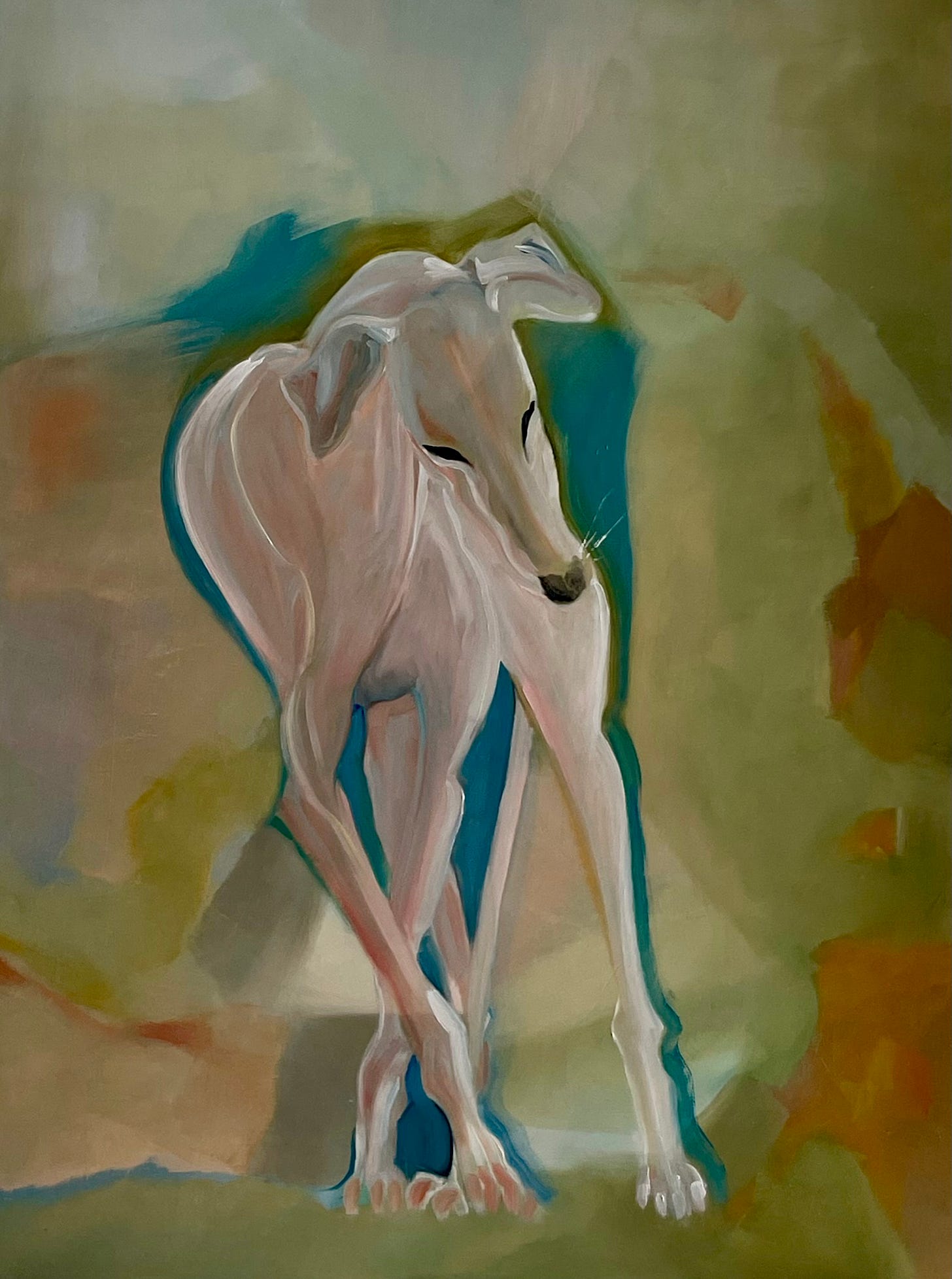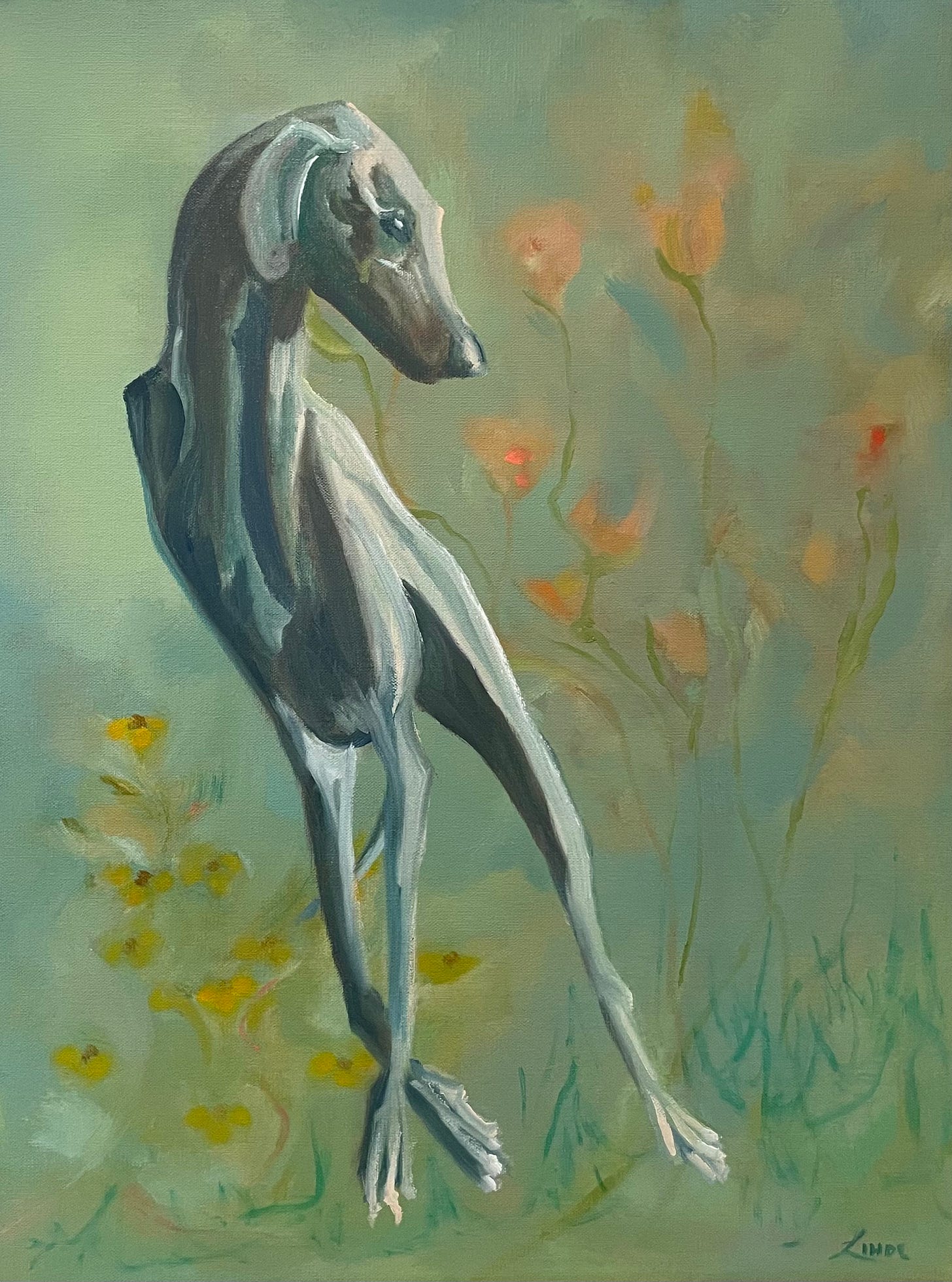I am slowly getting used to painting. That is, I can paint a bit. For the first couple years of my three years painting, I was preoccupied with how to make a stroke with my brush; what kind of stroke do I want to make? What kind of brush do I like to use? I was also intimidated by the canvas. The white or off white expanse seemed perfect in itself; a type of spaciousness mark free. Every mark seemed like a descent into ruination, a loud demonstration of poor skill and no training.
I also had trouble with mediums. A few of my paintings have never dried. I think they are now less tacky, and are no longer marred by my tentative finger tip, but clearly I did something wrong. I fooled with water soluble oils, regular oils, water color and acrylic and back to soluble oils again-settling there for the ease of clean up and freedom from noxious fumes.
And then, imperceptible at first, I stopped thinking about those things. I was focused on the composition of my painting, the colors and how well they harmonized. Finally the paint and brush became tools rather than things in themselves to be touched hesitantly, and haltingly.
I find myself thinking about how a painting needs to have a story. I am moving from landscape to figurative work. The paintings I once thought complete are now the backdrops for new work. Daphne, above, was painted over an abstract I did in 2022 and felt pleased with at the time. It was still nice, to me anyway, as an abstract, but the introduction of the greyhound gives me the sense that the painting is about something, and not just space. Space is nice, too, of course, but I am venturing into a new realm.
I remember when this happened with clay. Clay, once a magical medium in itself with its plasticity, became a material I worked with to evoke or demonstrate an idea. It became so familiar to me that my fingertip could tell me exactly what the clay could do at any given phase of drying. Sloppy slip to bone dry dust-clay is 100 different materials in one, each with its attributes. Paint is finally a material to me, and I can turn to the idea.
Cautiously I am approaching galleries, and being received. While I like to imagine I am indifferent to praise, I find people’s responses to my work encouraging and that encouragement starts to build my confidence.
I am still exploring my process. In doing so I am so grateful to be an artist. Finding beauty in the materials of this world feel like a means to respond to the astonishment of living.
It is very popular in current painting circles to explore the interface between intelligible imagery and abstraction. I am finding myself in that matrix as well, and I can see that I want to use both gesture that suggests a form, and gestures that don’t. Painters have been relieved of the necessity to paint realistically by photography (though both forms play with the virtuosity that the other demonstrates) and this has opened the door to more symbolic language in painting. I have felt that I have lacked a focal point that introducing figures has solved.
One of the aspects I am enjoying is the revelation of shape. Partially indicated shapes are quickly resolved by the eye. The incomplete arc is easily turned into a circle by the mind. We bring our criteria of intelligibility to the images we perceive. The mind craves the intelligible and that mind when it is the viewer, will change the painting in accord with the viewer’s particular interests.
This is the same principal that is demonstrated in word association, the simple technique introduced by Freud. You say hot, I say cold. Most associations are predictable. Those that aren’t, jolt the listener, are of particular interest to the clinical psychologist. You say hot, I say burnt. You say hot, I say gone. The oddity of the association immediately invites investigation.
I’m interested in symbol in art. In the case of my greyhound, “Daphne” her grace merges with the abstraction behind her. I imagine, that because she is an animal, she doesn’t introduce the same separateness from her enviornment as a human would. It soothes me to paint animals, even as I fantasize about doing portraits of people. I suppose I might be able to paint a person, but my inner state would have to be equal to the vast world of interiority that the face would suggest, an interiority that animals don’t seem to have. They are their enivornment in a way; from the agility of their bodies that move simultaneously in accord with their wishes, to the seeming lack of dividedness of their animal selves.
My painting process has changed. Currently I paint the background first, in a way that it could be a complete painting, and then I introduce the figures. I am not sure where this will lead me, but I find that I have many emotions about it, and even reflecting on my desire to paint humans fills me with some trepidation.
What is your process?
Namaste,
Leslie






I love hearing your honest, clear voice. I love to hear about your artistic explorations.
But tell me one thing— in the second image I see a greyhound with three legs. Is this the subject of the painting? Is the dog partially hidden? I don't understand how this environment hides this dog. A deformed animal raises a lot of different feelings in me. Animals, unless they are in pain or unable to keep up with their group, don't seem to mind. Frida Kahlo is famous for painting her own deformities. The idea of "deformity" when examined, reveals our minds. Yet I don't believe that this painting of a three-legged greyhound is about a deformity. Rather, I feel that something tricky is going on, and I feel unbalanced— yet I have confidence in that greyhound, that the dog is agile and surefooted nonetheless, because that is its spirit. A spirit-animal.